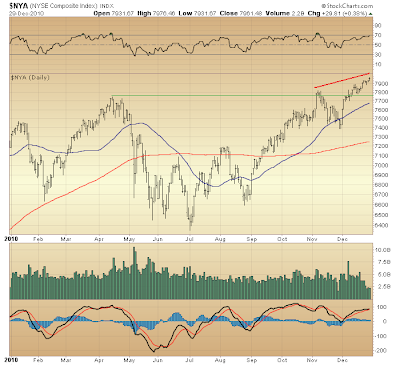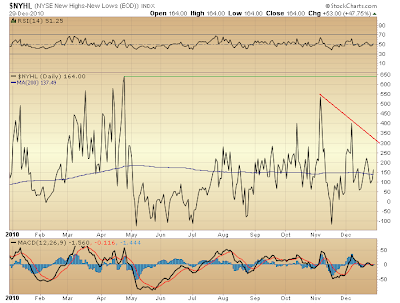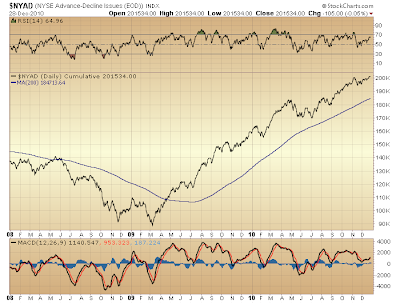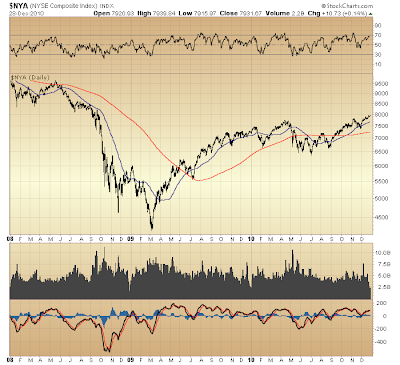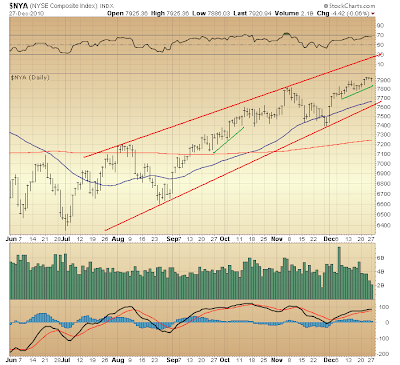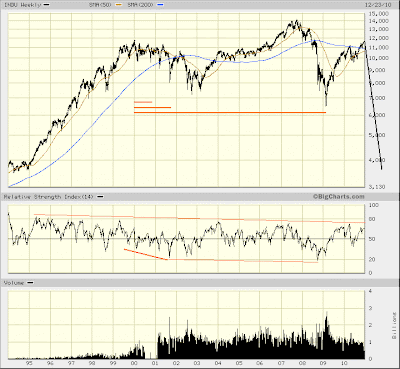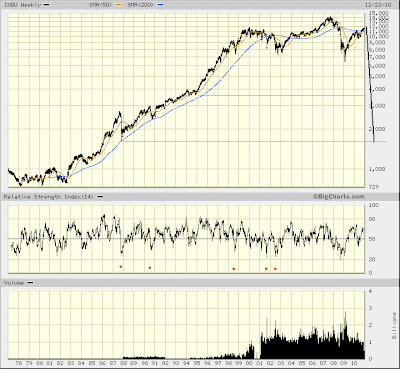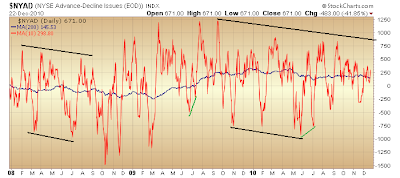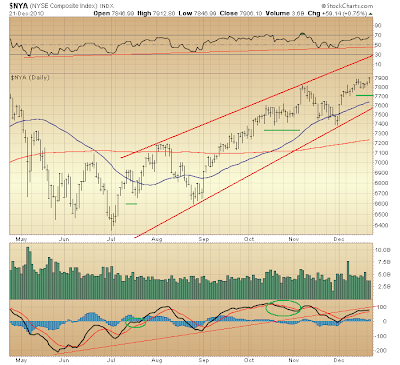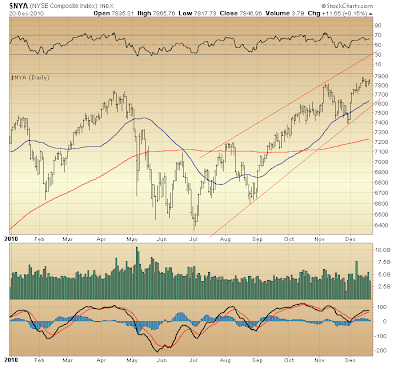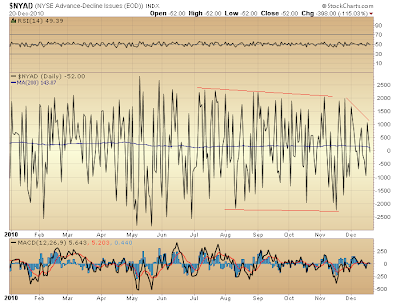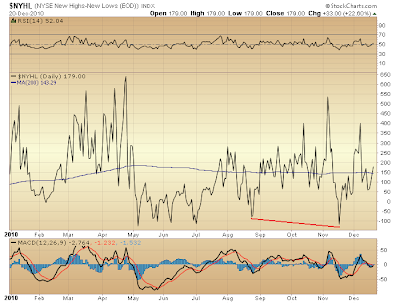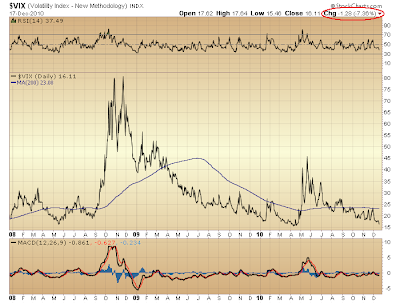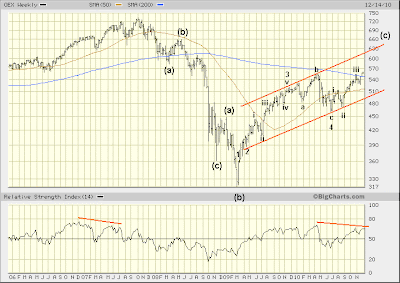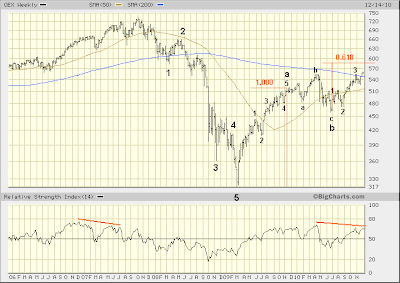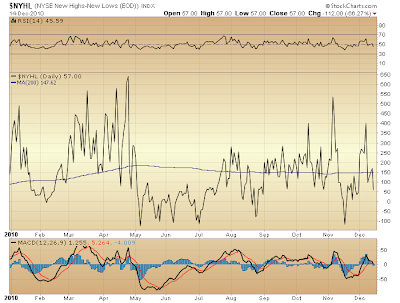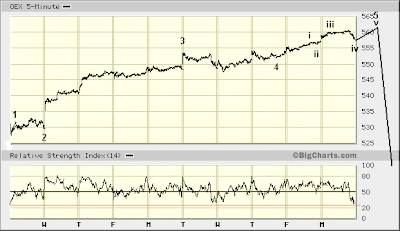The market's continued resiliency amidst extensive technical weakness begs consideration of whether its precipice might arrive early next year...

Having
yesterday pegged an OEX objective at 585, it's possible five waves up from late-June bottom are forming a "diagonal triangle," or a so-called "rising wedge," and so we might find the market's top reached sooner than previously thought likely — even as soon as early January 2011.
In light of the
likelihood that, a "c" wave might better be thought forming off late-June bottom (rather than a fifth wave), supporting the above "rising wedge" prospect, then, are coincident relative strength (top panel) and momentum (bottom panel). Buoyant RSI and MACD coincident with the market's advance thus far since late-June (as a rising wedge's first four waves, and now its fifth and final wave form) are seen developing in a manner fitting a "c" wave, thus too demonstrating a measure of dynamism typical of an Elliott third wave.
Yet truth is price resiliency persisting as it has (particularly since late-August), as well as [atypical] relative strength and momentum behavior coinciding with five waves up from late-June really are about the only displays of "dynamism" one might cite to qualify this presumed "c" wave completing an a-b-c Elliott corrective wave up from March '09 bottom. All else begs the conclusion that, "something is not right." Glaring underlying technical weakness surely elevates the risk that, the market's correction from October 2007 top could imminently resume with a vengeance.
To now one expressed view toward the prospect the market might levitate for some months more before coming unglued suggested that presently in progress was the forth wave of five waves up from late-June. Thus, a trip back toward 200-day moving averages was thought a reasonable probability in the process of completing this forth wave. Perhaps, though, the forth wave ended on November 30th, and presently unfolding is the fifth wave of a rising wedge forming
off late-June bottom.
Despite not being evident via RSI and MACD, typical technical deterioration coinciding with formation of the forth wave of a five wave advance (this relative to the preceding second wave) certainly can be seen via the
NYSE McClellan Oscillator. Indeed, November's market weakness saw the NYSE McClellan Oscillator dive well below its late-August low, thus lending technical justification supposing that, the forth wave of five waves up from late-June ended on November 30th. It stands to reason technical deterioration typically will increase as a five wave advance nears its completion. The NYSE McClellan Oscillator is demonstrating this.
So, the fifth and final wave of wave
c up from late-June presently could be unfolding. Likewise, its end targeting OEX 585 might be reached in a matter of a few weeks. Subsequently (and kicking off wave
(C) down from October 2007 top), expect a throttling silencing the masses whose consensus today is claiming 2011 will be positive — with many citing the third year in the presidential term cycle as typically being a bullish one for stocks (the fourth year, too, typically is positive per this same cycle, and this surely was not the way of things in 2008).
Only after this prospective "rising wedge" forming wave
c up from late-June bottom is fully retraced (and then some) will 2011 likely have any prospect of being "positive." Indeed, the market's indisputably negative technical state bodes very poorly for prospects in 2011. Whether a "rising wedge" off late-June bottom completes formation over the next few weeks, or a more typical Elliott five wave advance instead sees its fourth wave further develop (thus extending the duration over which wave
c forms, but not likely its upside objective), the market's weak technical state (long lasting though it has been) offers clear warning that, a calamitous collapse still remains very much fixed on the horizon.
Vanquished animal spirits amidst an increasingly fearless, hope-filled, optimistic captive interest is not the stuff offering a sure path higher in the stock market. Rather, we have here all the right ingredients for feeding a panic. I don't expect this condition to change as the corrective wave off March '09 bottom completes over weeks ahead, or as the first and second waves of wave
(C) down subsequently unfold.

* * * * *
© The Risk Averse Alert — Advocating a patient, disciplined approach to stock market investing. Overriding objective is limiting financial risk. Minimizing investment capital loss is a priority.
Analysis centers on the stock market's path of least resistance. Long-term, this drives a simple strategy for safely investing a 401(k) for maximum profit. Intermediate-term, investing with stock index tracking-ETFs (both their long and short varieties) is advanced. Short-term, stock index options occasionally offer extraordinary profit opportunities when the stock market is moving along its projected path.
Nothing is set in stone. Nor is the stock market's path of least resistance always known. More often than not, there are no stock index option positions recommended. There's an easy way to boost your investment discipline...
There's an easy way to boost your investment discipline...
Get Real-Time Trade Notification!
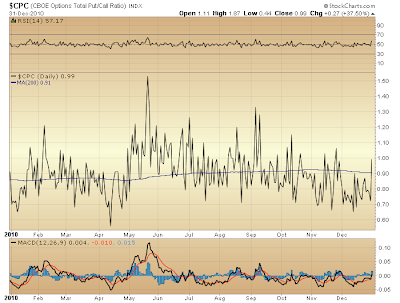
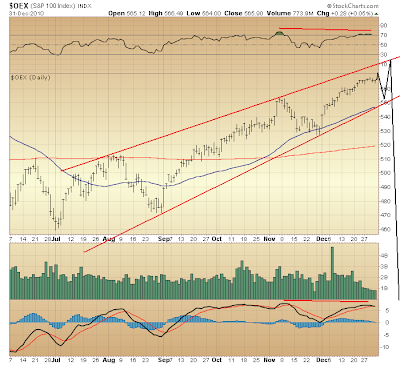

 There's an easy way to boost your investment discipline...
There's an easy way to boost your investment discipline...